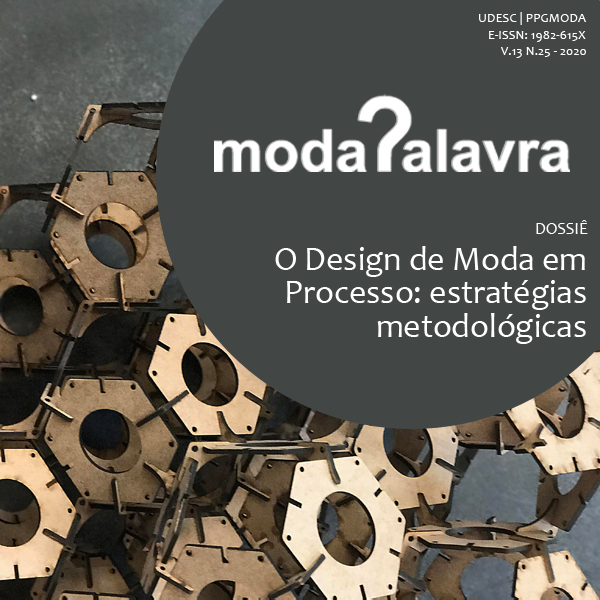¿Es posible cuantificar las funciones del vestido? una pregunta por los métodos de análisis funcional en el diseño.
DOI:
https://doi.org/10.5965/1982615x13272020138Palavras-chave:
diseño de vestuario, métodos ergonómicos, cuerpo-vestidoResumo
Cuando nos enfrentamos al estudio del vestido desde su identidad artefactual, observamos que su denominada dimensión funcional no puede ser comprendida en los mismos términos propuestos por la ergonomía del producto, esto es, a partir de los conceptos ergonómicos de usabilidad, eficiencia y eficacia en relación a una actividad o un trabajo determinado.
El presente artículo, presenta los resultados de una revisión de la aplicación de los métodos ergonómicos comúnmente usados por el diseño para el estudio del vestido y explica por qué resultan insuficientes o limitados para abordar las múltiples funciones de este particular artefacto. Al mismo tiempo, propone algunas consideraciones para su análisis funcional que aporten de manera decisiva al proceso proyectual del diseño del vestir.
Downloads
Referências
ALADJEM, Avraham; et all. Enciclopedia de Salud y seguridad del trabajo.4ª Edición. Madrid: Ministerio de Trabajo y Asuntos Sociales Subdirección General de Publicaciones, 2012. Disponible en: http://www.insht.es/portal/site/Insht/menuitem.1f1a3bc79ab34c578c2e8884060961ca/?vgnextoid=a981ceffc39a5110VgnVCM100000dc0ca8c0RCRD&vgnextchannel=9f164a7f8a651110VgnVCM100000dc0ca8c0RCRD
BARTHES, Roland. El Imperio De Los Signos. Madrid: Mondadori, 1970.
BARTHES, Roland. El Sistema De La Moda. Barcelona: Gustavo Gili, 1978.
BAYÁ, N. Seminarios: Contexto. Buenos Aires: Nobuko. 2006.
BOAS, Franz. Cuestiones Fundamentales De Antropología Cultural. Buenos Aires: Solar, 1940
BRANSON, David; Sweeney, Martin. Critical Linkages in Textiles and Clothing Subject Matter: theory, method and practice. Monument: International Textile and Apparel Association, 1991
BRONCANO, Fernando. Entre ingenieros y ciudadanos: Filosofía de la técnica para días de democracia. Barcelona: Montesinos, 2006.
DUNNE, Lucy; WATKINS, Susan. Functional Clothing Desgin: from sportwear to spacesuit. 3a Edición. Estados Unidos: Bloomsbury, 2015.
ECO, Umberto. La estructura ausente: introducción a la semiótica. Barcelona: Lumen, 1968.
EICHER, Joanne;LEE EVENSON, Sandra. The Visible Self: Global Perspectives on Dress, Culture and Society. New York: Bloomsbury, 2013
ENTWISTLE. Joanne. El cuerpo y la moda: una visión sociológica. Barcelona: Paidós, 2002
ESTRADA, Jairo. Ergonomía Básica. 1ª edición. Bogotá: Ediciones de la U, 2015.
FERNÁNDEZ, Claudia. La Profundidad De La Apariencia: contribuciones a una teoría del diseño de vestuario. Medellín: Editorial UPB, 2015.
FERNÁNDEZ-SILVA, Claudia. El vestido como artefacto del diseño: Contribuciones para su estudio y reflexión al interior del pensamiento del diseño. Encuentros, v.16. jul.-dic. 2018. Disponible en: https://proyectomedussa.com/el-vestido-como-artefacto-del-diseno-contribuciones-para-su-estudio-y-reflexion-al-interior-del-pensamiento-del-diseno/
FLORES, Cecilia. Ergonomía para el Diseño. México: Designio, 2001.
KELLY, Marjorie. Clothes, cultures and culture: female dress in Kwait. Fashion theory, v.4, n.2, pp.215-236. 2010
LÉVI-STRAUSS, Claude. El pensamiento salvaje. Ciudad de México: FCE, 1962
MARTÍNEZ, Ana. La construcción social del cuerpo en las sociedades contemporáneas. Papers, v.73, pp.127-152. 2004.
MOLES, Abraham. Teoría de los objetos. Barcelona: Gustavo Gili S.A., 1989
NEVADOMSKY, Joseph; AISIEN, Ekhaguosa. The clothing of political identity: costume and scarification in the Benin kingdom. African Arts, v.28, n.1, p.62-73. Jun. 1995.
SÁENZ, Luz. Ergonomía & diseño de productos propuesta metodológica para la docencia y la investigación. Actas de diseño. v.03. Disponible en: http://fido.palermo.edu/servicios_dyc/encuentro2007/02_auspicios_publicaciones/actas_diseno/articulos_pdf/A038.pdf
SÁENZ, Luz. Ergonomía & diseño: análisis y aplicación para calzado laboral. Iconofacto, v.04, n.5, p.122-139, dic.2008. Disponible en: file:///C:/Users/windows%208.1/Downloads/Dialnet-ErgonomiaYDisenoAnalisisYAplicacionParaCalzadoLabo-5204292%20(1).pdf
SCHNEIDER, Jane. The Antropology of Cloth. Anual Review of Anthropology, v.16, pp.409-448, 1984.
SONG, Guowen. Improving Comfort in Clothing. Oxford: Woodhed Publishing, 2011.
STORM, Penny. Functions of Dress: Tool of Culture and the Individual. New Jersey: Prentice Hall College, 1986.
TAYLOR, Frederick. The principles of scientific management. New York: Harper Bros, 1911.
VINCENT, Susan. The Anatomy of Fashion Dressing the Body from the Renaissance to Today. Londres: Berg, 2009.
WILLIAMSON, Bess. Getting a Grip Disability in American Industrial Design of the Late Twentieth Century. Winterthur Portfolio, v.46, n.4, pp.213-236. 2012.
Downloads
Publicado
Como Citar
Edição
Seção
Licença
Copyright (c) 2019 Claudia Fernández-Silva, Camila Pastás Riáscos, Juan David Mira Duque

Este trabalho está licenciado sob uma licença Creative Commons Attribution-NonCommercial 4.0 International License.
Ao submeter um artigo para publicação no ModaPalavra e-periódico, o(s) autor(es) concorda(m) com os seguintes termos:
- Autores mantêm os direitos autorais e concedem à revista o direito de primeira publicação, com o trabalho simultaneamente licenciado sob a Creative Commons Atribuição-NãoComercial 4.0 Internacional, que permite o compartilhamento do trabalho com reconhecimento da autoria e publicação inicial nesta revista, sem pagamento;
- Os autores podem utilizar os mesmos resultados em outra publicações após a primeira publicação, desde que indiquem o ModaPalavra e-periódico como o meio de publicação original;
- Autores têm autorização para assumir contratos adicionais separadamente somente após a publicacão inicial no ModaPalavra e-periódico, desde que indiquem o ModaPalavra e-periódico como o meio de publicação original;
- Autores têm permissão e são estimulados a publicar e distribuir seu trabalho on-line (ex.: em repositórios institucionais ou na sua página pessoal), somente após o processo editorial e primeira publicação, desde que indiquem o ModaPalavra e-periódico como o meio de publicação original;
- Para indicar o ModaPalavra e-periódico como o meio de publicação original, o autor deve seguir texto modelo: "Este artigo foi publicado originalmente pelo ModaPalavra e-periódico, sob a licença CC BY NC, em seu volume [inserir volume], número [inserir número] no ano de [inserir ano], e pode ser acessado em: http://www.revistas.udesc.br/index.php/modapalavra/";
- As opiniões expressas nos artigos são de inteira responsabilidade dos autores, não refletindo necessariamente a opinião da revista. A publicação de artigos, fotos e desenhos foi autorizada previamente pelos responsáveis ou seus representantes para publicação no ModaPalavra e-periódico.









